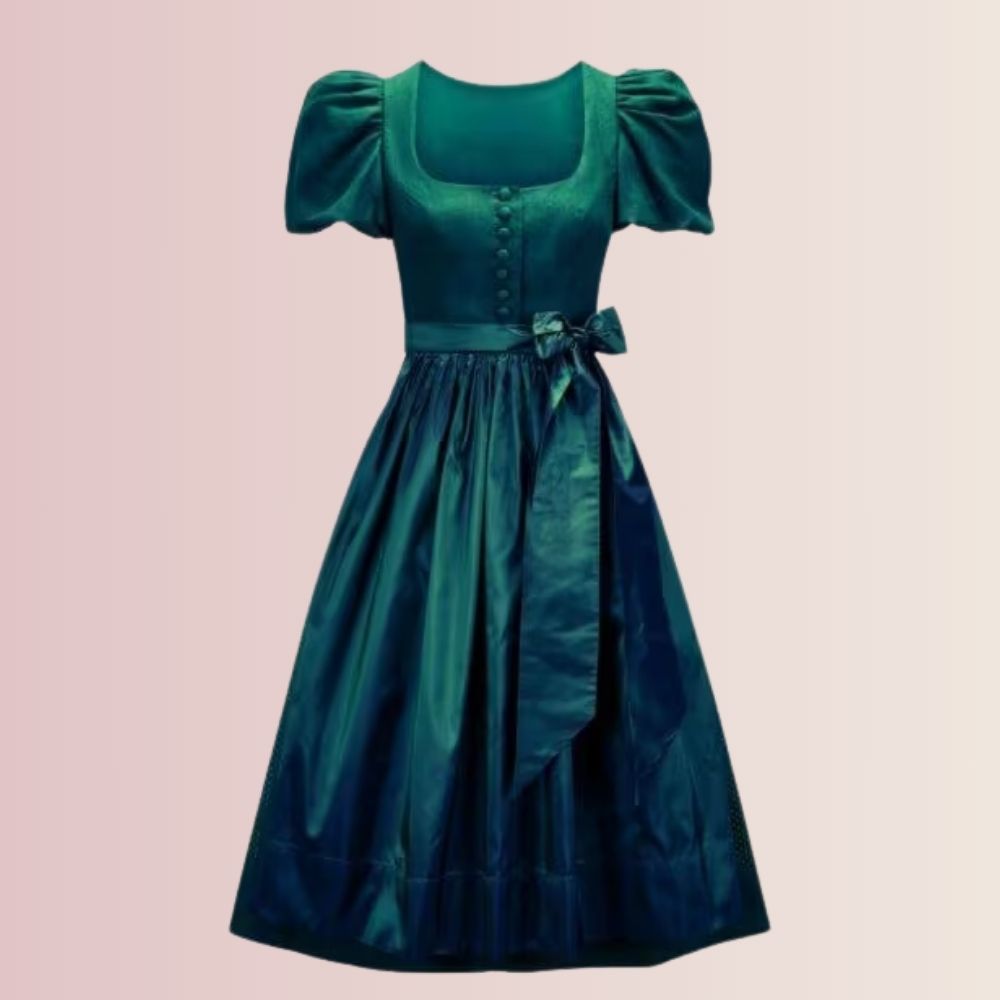German Dirndl Dress Outfit: A Celebration of Bavarian Heritage
The German Dirndl Dress Outfit is a timeless emblem of Bavarian culture, blending tradition, craftsmanship, and feminine elegance. Whether you’re twirling in a beer tent at Oktoberfest, attending a rustic wedding, or celebrating your German roots, this iconic ensemble captures the spirit of Alpine heritage. With its fitted bodice, vibrant skirts, and symbolic apron, the Dirndl dress is more than attire—it’s a story woven into fabric.
In this guide, we’ll explore the history, design, and styling secrets of the German Dirndl Dress Outfit, along with tips for choosing, caring for, and accessorizing your look. Let’s step into the world of Bavarian tradition!
The History of the German Dirndl Dress Outfit
The German Dirndl Dress Outfit originated in the 19th century as practical workwear for women in Bavaria and Austria. The term “Dirndl” (meaning “young woman” in regional dialect) referred to the dress’s humble beginnings as attire for servants and farmers. Its simple design—a fitted bodice, full skirt, and apron—prioritized durability for laborious tasks.
By the early 20th century, the Dirndl evolved into a symbol of regional pride. Urban designers reimagined it with luxurious fabrics like silk and velvet, intricate embroidery, and delicate lace. Today, the German Dirndl Dress Outfit is synonymous with Oktoberfest, weddings, and folk festivals, celebrating both history and modern femininity.
Key Features of a German Dirndl Dress Outfit
Authentic German Dirndl Dress Outfits are defined by meticulous craftsmanship and cultural symbolism:
- The Bodice:
- Snug and structured, often adorned with hand-stitched embroidery, floral patterns, or antique buttons.
- Accentuates the waist for a flattering silhouette.
- The Blouse:
- A lightweight, puff-sleeved Dirndl blouse in white or cream, featuring lace collars or ruffled details.
- The Skirt:
- Knee-length and full, crafted from cotton, linen, or silk for ease of movement.
- Vibrant colors like Bavarian blue, forest green, or ruby red reflect regional symbolism.
- The Apron:
- Tied in a bow around the waist, with placement indicating marital status:
- Left side: Single.
- Right side: Taken.
- Back: Widowed.
- Tied in a bow around the waist, with placement indicating marital status:
- Accessories:
- Bodice jewelry (chains, edelweiss pins), traditional footwear (Haferlschuhe), and floral crowns complete the look.
Why Choose a German Dirndl Dress Outfit?
- Cultural Authenticity: Honor Bavarian traditions with designs rooted in centuries of heritage.
- Timeless Elegance: The Dirndl’s silhouette flatters all body types and transcends fleeting trends.
- Versatility: Perfect for Oktoberfest, weddings, festivals, or even themed parties.
- Quality Craftsmanship: German-made outfits prioritize natural fabrics and durable stitching for longevity.
How to Style Your German Dirndl Dress Outfit
1. Classic Oktoberfest Ensemble
- Dirndl Dress: Opt for bold red or green with floral embroidery.
- Blouse: Pair with a white puff-sleeve blouse and lace trim.
- Apron: Choose a contrasting color (e.g., white apron with a red Dirndl).
- Accessories: Add a beer stein necklace, braided hairstyle, and ankle boots.
2. Sophisticated Wedding Guest Look
- Dirndl Dress: Soft pastels (ivory, blush) with gold-thread detailing.
- Blouse: High-neck lace for refinement.
- Apron: Silk or satin in neutral tones.
- Footwear: Strappy heels and a pearl clutch.
3. Casual Summer Outing
- Dirndl Dress: Lightweight cotton in gingham or polka dots.
- Blouse: Sleeveless for breathability.
- Footwear: Espadrilles or sandals.
- Extras: Straw hat and crossbody bag.
4. Winter Festival Attire
- Dirndl Dress: Velvet or wool in deep burgundy or navy.
- Layering: Thermal blouse, knit tights, and a faux-fur shawl.
- Footwear: Knee-high boots with wool socks.
Choosing the Perfect German Dirndl Dress Outfit
- Fit First:
- Ensure the bodice hugs snugly without restricting movement.
- Skirts should fall just below the knee for traditional appeal.
- Fabric Matters:
- Cotton and linen for summer; wool or velvet for winter.
- Color Symbolism:
- Blue: Loyalty and tranquility.
- Green: Connection to nature.
- Red: Passion and celebration.
- Authentic Details:
- Look for hand-embroidered edelweiss, heart-shaped bodices, and apron ties.
Caring for Your German Dirndl Dress Outfit
- Washing:
- Hand wash in cold water or use a gentle cycle. Avoid bleach.
- Spot-clean embroidery with mild soap.
- Drying:
- Air dry flat to preserve fabric and shape.
- Storage:
- Hang on a padded hanger, covered with a breathable cloth.
- Ironing:
- Use low heat and a pressing cloth over delicate areas.
Where to Buy Authentic German Dirndl Dress Outfits
For genuine German Dirndl Dress Outfits, shop from trusted sources:
- Local Trachten Stores: Visit Munich or Salzburg for in-person fittings.
- Online Retailers:
- DirndlHaus: Handmade designs with customizable options.
- Bavaria-Boutique: Blends tradition with modern trends.
- Etsy: Artisan-crafted pieces with unique details.
Pro Tip: Verify “Made in Germany” labels and natural materials like cotton or linen.
Conclusion: Embrace Tradition with a German Dirndl Dress Outfit
A German Dirndl Dress Outfit is more than clothing—it’s a vibrant link to Bavarian culture, history, and community. Whether you’re clinking steins at Oktoberfest or dancing at a folk festival, this attire ensures you celebrate with authenticity and grace.
By choosing a high-quality Dirndl, you’re investing in a piece of living heritage. Ready to elevate your wardrobe? Explore our curated collection of German Dirndl Dress Outfits and step into a legacy of timeless elegance.
Call to Action: Find your perfect German Dirndl Dress Outfit today! Shop handcrafted designs, enjoy free shipping on orders over €150, and celebrate Bavarian tradition in style. Prost! 🍻








Reviews
There are no reviews yet.